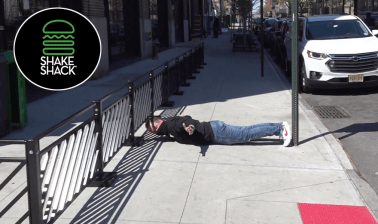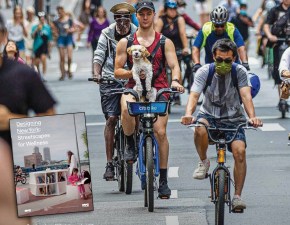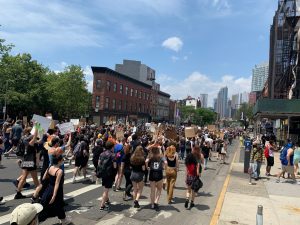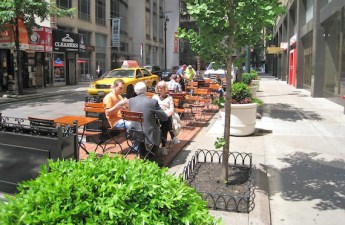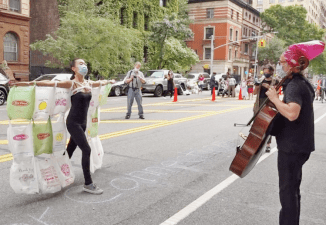The ‘Al Fresco Economy’: Restaurants Want to Start NYC’s Revival — All They Need is Space
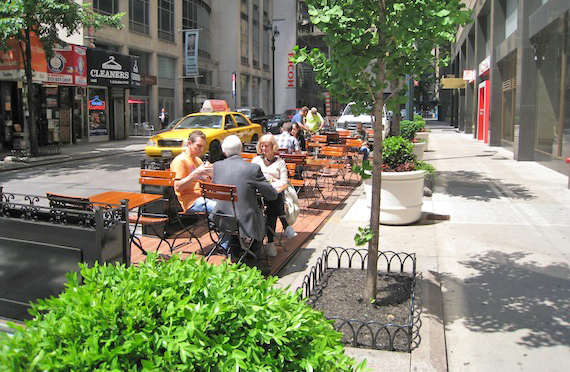
Open streets can save a shuttered economy.
A group of Manhattan restaurateurs is hopeful that the de Blasio administration will expand its “open streets” program beyond its current passive recreation mandate to allow eateries to repurpose public roads for the ultimate public purpose: to jumpstart an economy and put New Yorkers back to work.
Upper West Side restaurant fixture Henry Rinehart, who owned Henry’s for about 20 years before he sold it in 2018, is leading the effort — one, he says, that will start the process of reviving an industry that employs hundreds of thousands of people in the New York area.

“My people are hurting,” Rinehart told Streetsblog of the larger community, which includes restaurant owners, but also the hundreds of thousands of workers who keep eateries supplied and operating. “My city is hurting. Our leaders are not creating the safety and certainty that our lives, and our jobs require. The devastation and desperation is hidden behind closed doors for now, but if you poke around you can hear very clearly that people need to plan for the future.”
Cities around the world are already pursuing two seemingly unconnected coronavirus strategies that are not actually disconnected: creating open space so that people can get outside without violating social distance rules and planning how to jumpstart the economy. Many outlets have hailed efforts in Vilnius, the Lithuanian capital, to turn a huge swath of downtown into an open-air cafe, but similar strategies are being employed closer to home. Tampa, Fla. allowed restaurants to set out tables in the street in what it called “Business Recovery Zones.”
And Cincinnati — that restaurant hotbed — is opening 25 streets in two neighborhoods to help restaurants reopen.
The de Blasio administration was slow to pursue open streets. Rinehart and others are hoping it will seize this opportunity.
Since early May, Rinehart has been making frenzied calls to generate support from scores of restaurant industry leaders including Andrew Rigie of the New York Hospitality Alliance, whose group includes some of the biggest names in the business. The goal is to have a plan in place for the first nice day after the official “pause” ends — which is looking more and more like June 7.
“When the weather changes, after 100 days of solitude, we are all going to be desperate to be together, but to be safe,” Rinehart said. “And safety requires space. There is available public space in front of every door.”
The challenge, of course, is Mayor de Blasio, who has consistently been unwilling to see public roadways as anything but space for cars. His first open streets program, run by the NYPD, involved so much police staffing that it was killed after 11 days. The current open streets effort, which currently consists of mostly roadways in parks or residential streets adjacent to parks, is so timid that it can’t jumpstart the economy in the way Rinehart envisions.
“Open streets are a form of economic development,” he said. “Think of Stone Street — only with less crowding, obviously.”
BREAKING: Calgary Council today unanimously supported a plan to support restaurants by allowing outdoor seating to temporarily spill out onto public sidewalks & streets at no cost (fees waived, process cut). Via ?@DruhFarrell?
All cities, take note. https://t.co/H3rEKaXES4
— Brent Toderian (@BrentToderian) May 11, 2020
Here’s how it would work:
Hundreds of roadways in the city would be closed to all vehicles, and parking eliminated, to allow for restaurants to put their tables directly in the roadbed (leaving room only for emergency vehicles). The closure could simply be in the form of sawhorses or gates, like the current open streets plan. It does not require the involvement of the NYPD, Rinehart said.
“There is no enforcement issue; restaurants have been enforcing safe streets since the beginning of time,” he said. “We sweep up, we oversee the area, we put half our tables outside. All we need is coordination from City Hall.” (It is unclear at this time how such a program would work in neighborhoods with less restaurant density than, say, Manhattan.)
Existing technology would make it easy for a restaurant on, say, Columbus Avenue between 77th and 78th streets to serve someone sitting at a table on W. 76th between Columbus and Amsterdam avenues, Rinehart said.
“With the advent of geo-location technology, much of what was formerly full-service dining rooms will morph into food that is pre-ordered, pre-paid, and delivered outside to a cafe, or around the corner, to blocks away,” he said. “But obviously the city should focus on keeping the distance between kitchen and table as short as possible. But space is the key. Tables would have to be spaced at a distance that would allow people seated to be at least six feet apart, so we need the entire street bed.”
Streetfilms made a video the other day with Shabazz Stuart, CEO of Oonee, the bike parking company, who is on Rinehart’s steering committee:
Other open streets advocates are on board.
“Restaurants will need to reopen yet maintain physical distancing, which is impossible to do in a limited footprint — but there is plenty of street space in New York,” said Danny Harris, the executive director of Transportation Alternatives. “Our street usage right now is inequitable and is not serving the people. It needs to be reallocated. This is not a heavy lift.”
Roadways could easily be configured so that the elderly or disabled could be dropped off at their destinations, and deliveries could still be made, albeit at 5 miles per hour in the newly created shared space, Harris added.
A lot will depend on the de Blasio administration’s reaction to the proposal. Two sources told Streetsblog that for now at least, this is one of the last things on the mayor’s mind. “There’s a lack of bandwidth right now,” one source familiar with City Hall told Streetsblog.
But Department of Transportation Commissioner Polly Trottenberg told the City Council on Tuesday that there is an “inter-agency group looking at how you would manage [restaurant seating] and permitting issues.”
Rinehart does not believe he needs much help from the city — except maybe to just “stay out of the way.”
“Let us get it done and do not over-regulate us,” he said. “There’s no time for gross incompetence. We have thousands of employees all sitting at home saying, ‘Put me in, coach.’ This could be the best block party in the history of New York, but if we don’t get this right in the next three months, there will be a complete collapse of the tax base of the city.”
Here’s the full text of Rinehart’s call to arms:
